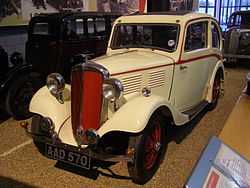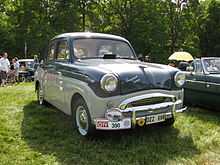Standard Ten

The Standard Ten was a small car produced by the British Standard Motor Company (discontinuously) from 1906 to 1961.
The name was first used in 1906 as the 10 hp, with a 631 cc 2-cylinder side-valve engine. It was re-used from 1934 to 1936 and again for the "Flying 10" launched in 1937, and produced until the outbreak of World War II. The name originally was a reference to the car's fiscal horsepower, in turn a function of the surface area of the pistons, and never a direct measure of the power produced by the engine. Like other manufacturers, Standard continued to use the name to define the approximate size of their 'Ten' model long after the origins of the name had, in Britain, become inapplicable.
The Ten and its up-market sibling, the Pennant, were replaced by the Triumph Herald in 1961.
Flying Ten
| Standard Flying Ten | |
|---|---|
| Overview | |
| Production |
1937–1940 production – not available |
| Body and chassis | |
| Body style | saloon |
| Powertrain | |
| Engine | 1267 cc Straight-4 |
| Transmission | Three speed manual |
| Dimensions | |
| Wheelbase | 90 in (2,286 mm)[1] |
| Length | 152 in (3,861 mm)[1] |
| Width | 56 in (1,422 mm)[1] |
The Flying Ten was a replacement for the earlier Ten with the semi-streamlined look of the Standard Flying range. The side-valve 1267 cc long stroke (100 mm) engine had a single Zenith carburettor and could produce 33 bhp (25 kW) at 4000 rpm.[1] Drive was to the rear wheels through a 3-speed synchromesh gearbox. The suspension was conventional at first with a solid front axle but this was upgraded to an independent set-up at the front with a transverse leaf spring in 1939. A top speed of around 65 mph (105 km/h) was attainable. Brakes were cable operated using the Bendix system. In early 1941, 150 four-doors were built for the military, after civilian production had ceased.
A sportier version, the Light Flying Ten was also made.
Standard Ten
| Standard Ten | |
|---|---|
 | |
| Overview | |
| Also called |
Standard Companion Standard 6 cwt [2] Standard Vanguard Junior Triumph TR-10 |
| Production |
1954–1960 172,500 made [3] |
| Assembly |
United Kingdom Australia [4] |
| Body and chassis | |
| Body style |
4-door saloon 4-door estate car 2-door coupe utility [2] 2-door panel van [2] |
| Powertrain | |
| Engine | 948 cc Straight-4 ohv |
| Transmission |
Four speed manual optional overdrive |
| Dimensions | |
| Wheelbase | 84 inches (2134 mm) [1] |
| Length | 144 inches (3658 mm) [1] |
| Width | 60 inches (1524 mm) [1] |
| Height | 60 in (1,500 mm)[5] |
In 1954 the Ten was introduced as a larger-engined (and less basic) version of the Standard Eight, though sharing a similar frame and transmission. Overdrive (from March 1957) or a temperamental semi-automatic were available as options. An estate (station wagon) version, the Companion was launched in 1955. It was among the first small British estate cars to have rear-passenger doors (like the saloon, and unlike its rivals such as the Ford Squire and Hillman Husky which used the two-door "van" arrangement).
A small number of left-hand-drive Tens were exported to the USA and sold as the Triumph TR-10. On these, the two-tone colour arrangement normally reserved for the Pennant was available (though this export model was not tailfinned).
A Ten saloon tested by the British magazine The Motor in 1954 had a top speed of 69.0 mph (111.0 km/h) and could accelerate from 0-60 mph (97 km/h) in 38.3 seconds. A fuel consumption of 34.4 miles per imperial gallon (8.2 L/100 km; 28.6 mpg-US) was recorded. The test car cost £580 including taxes.[6]
In 1955, supported by an inscrutable handicapping régime favouring small cars, a factory-prepared Standard Ten, driven by Jimmy Ray and Brian Horrocks, won the UK's RAC Rally.[7]
For the United States export market the car was badged as the Triumph Ten and in Scandinavia it was sold as the Standard Vanguard Junior. In Australia the Ten was known as the Cadet.[8]

Standard Pennant
| Standard Pennant | |
|---|---|
 | |
| Overview | |
| Production |
1957–1960 42,910 made [3] |
| Body and chassis | |
| Body style | saloon, estate |
| Powertrain | |
| Engine | 948 cc Straight-4 |
| Transmission |
Four speed manual optional overdrive |
| Dimensions | |
| Wheelbase | 84 in (2,100 mm) [1] |
| Length | 144 in (3,700 mm)[1] |
| Width | 60 in (1,500 mm) [1] |
| Height | 60 in (1,500 mm)[9] |
A tail-finned (with optional two-tone paint schemes) version of the Ten, the Standard Pennant was launched in 1957. Engine power was increased to 37 bhp[3] and an overdrive gearbox was offered as an option. other options included a radio, heater, leather upholstery and clutchless 2-pedal control. Indian-produced Pennants were branded as "Standard 10", and lacked any bootlid trim other than the branding.
A Pennant tested by British magazine The Motor in 1958 had a top speed of 70.2 mph (113.0 km/h) and could accelerate from 0-60 mph (97 km/h) in 35.3 seconds. A fuel consumption of 40.2 miles per imperial gallon (7.03 L/100 km; 33.5 mpg-US) was recorded. The test car cost £728 including taxes of £243.[9]

References
- ↑ 1.0 1.1 1.2 1.3 1.4 1.5 1.6 1.7 1.8 1.9 Culshaw; Horrobin (1974). Complete Catalogue of British Cars. London: Macmillan. ISBN 0-333-16689-2.
- ↑ 2.0 2.1 2.2 British commercial brochures Retrieved on 28 October 2011
- ↑ 3.0 3.1 3.2 Robson, G. (2006). A-Z of British Cars 1945–1980. Devon, UK: Herridge Books. ISBN 0-9541063-9-3.
- ↑ Australian Motor Industries (AMI) The Start Retrieved on 30 March 2012
- ↑ "Second Hand car guide supplement". Practical Motorist. 6 Nbr 68: between pages 768 & 769. date April 1960.
- ↑ "The Standard Ten". The Motor. 4 August 1954.
- ↑ "XK to Escort – 25 years of RAC Rallies". Autocar. 147 (nbr 4228): pages 40–41. date 19 November 1977.
- ↑ Standard 8's and 10's Page Retrieved from www.standardmotorclub.org.uk on 23 February 2009
- ↑ 9.0 9.1 "The Standard Pennant". The Motor. 10 September 1958.
External links
| Wikimedia Commons has media related to Standard Ten. |
| Wikimedia Commons has media related to Standard Pennant. |
| Triumph Motor Company timeline, 1946–1984 — a marque of British Leyland | |||||||||||||||||||||||||||||||||||||||||
|---|---|---|---|---|---|---|---|---|---|---|---|---|---|---|---|---|---|---|---|---|---|---|---|---|---|---|---|---|---|---|---|---|---|---|---|---|---|---|---|---|---|
| type | 1940s | 1950s | 1960s | 1970s | 1980s | ||||||||||||||||||||||||||||||||||||
| small family car | Triumph Mayflower (1949 - 1953) |
Triumph Herald (1959 - 1971) |
Triumph Dolomite (1972 - 1980) |
Triumph Acclaim (1981 - 1984) | |||||||||||||||||||||||||||||||||||||
| Triumph Vitesse (1962 - 1971) | |||||||||||||||||||||||||||||||||||||||||
| TR-10 | Triumph 1300 | ||||||||||||||||||||||||||||||||||||||||
| Triumph 1500 | |||||||||||||||||||||||||||||||||||||||||
| Triumph Toledo | |||||||||||||||||||||||||||||||||||||||||
| large family car | Triumph 1800 Town & Country | Triumph 2000 Saloon | Triumph Renown | Triumph 2000 | |||||||||||||||||||||||||||||||||||||
| Convertible | Triumph 1800 Roadster | Triumph 2000 Roadster | Triumph Stag | ||||||||||||||||||||||||||||||||||||||
| coupé | Triumph Italia | Triumph GT6 | |||||||||||||||||||||||||||||||||||||||
| Sports Car | TR-X | 20TS | Triumph TR2 | Triumph TR3 | Triumph TR3A | Triumph TR5 | Triumph TR7 | ||||||||||||||||||||||||||||||||||
| Triumph TR3B | Triumph TR4A | Triumph TR6 | |||||||||||||||||||||||||||||||||||||||
| Triumph TR4 | Triumph TR250 | Triumph TR8 | |||||||||||||||||||||||||||||||||||||||
| Triumph Spitfire | |||||||||||||||||||||||||||||||||||||||||